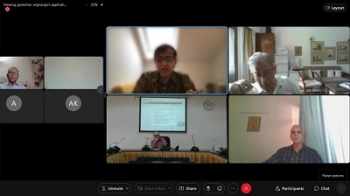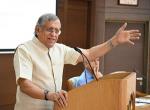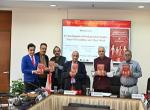On the 20th of May, 2022, the Vivekananda International Foundation organized a discussion on the 'Implications of the Political and Economic Crisis in Sri Lanka'. The session began with Dr Ganesh Wignaraja, Senior Research Associate at the Overseas Development Institute in London, presenting the causes and consequences of Sri Lanka's current economic predicament. This was followed by a series of remarks by discussants Ambassador Ashok K. Kantha, Director at the Institute of Chinese Studies at Delhi, and Shri PM Hebilkar, Former Special Secretary at the Government of India. Alongside delving into the economic aspects of the crisis, the discussion also examined a range of political issues that are fundamental to understanding Sri Lanka's prospects for recovery.
Dr Wignaraja began by outlining the nature and present status of Sri Lanka's debt crisis. On the 12th of April, 2022, he remarked, Sri Lanka undertook a soft default on its foreign debt and stated its intent to suspend payments temporarily. Moreover, the country also announced the appointment of a new central bank governor to assist it in this crisis. Sri Lanka's public debt to GDP ratio has risen from 91 per cent (2018) to 119 per cent (2021). A vast majority of this debt is external debt, with the country's external debt to GDP ratio standing at 61 per cent. In more practical terms, Sri Lanka owes six billion US Dollars in debt against low foreign debt reserves. If one were to consider Sri Lanka's pre-default payment statistics, the country would have owed four to five billion US dollars in external debt payments annually.
Accompanying Sri Lanka's default story are rising levels of stagflation in the country, mainly characterized by a fall in per capita income. Having incurred supply shocks due to the COVID-19 pandemic and the Russian Invasion of Ukraine, the Sri Lankan economy is experiencing inflation rates of 30 per cent a year. These figures are further compounded by the current food inflation rate, at 50 per cent a year, and a rising demographic of citizens below the poverty line. Consequently, the country's streets have seen a series of chaotic public protests. Moreover, Sri Lanka also saw a black day when public unrest spilt over into violence, burnings around Colombo and the destruction of Parliamentarians' houses. This is particularly significant since the Rajapaksas, the ruling party, came to power with a two-thirds majority. This crisis has marked their dramatic downfall, with Mahendra Rajapaksa being forced out of office to make way for Ranil Wickremesinghe.
Dr. Wignaraja then proceeded to evaluate the events that led to this crisis. He noted that the economy was already weak, even much before the onset of the pandemic. One of the reasons he attributed was the costly Sri Lankan Civil War that ended in 2009. He specifically emphasized that the conflict cost the country 1 per cent of its GDP growth per year. Additionally, Dr. Wignaraja drew attention to Sri Lanka's twin-deficit problem- being a large welfare state; it spends more than its tax revenues and its exports are not adequate; as also foreign investment and tourism revenues have declined. These factors were exacerbated by the Sri Lankan government's tendency to borrow excessively for low-return infrastructure projects from countries like China. As his second point, Dr Wignaraja shed light on how the pandemic and current global geopolitical scenario further weakened the Sri Lankan economy with external shocks. The country was adversely impacted by COVID-19, with the economy contracting by 3.9 per cent and generating over half a million new poor. The Russian invasion of Ukraine and the following rates of core inflation created further problems regarding Sri Lanka's debt issue.
Dr Wignaraja then outlined the impacts of the Rajapaksa government's policy missteps in compounding this crisis. One of the most significant errors was the government's very populist decision to go in for massive tax cuts in 2019- in an attempt to pacify its business supporters. It is also possible that the government expected its decision to encourage investment by large conglomerates and foreign investors, gradually spurring economic growth. This result, however, did not materialize. In addition to this step, the government also opted to ban chemical fertilizer imports overnight without preparing farmers for the shift to organic fertilizers. This led to a massive fall in the productivity and output of an already waning agriculture sector. As to why the government made such a decision was that it wanted to save on import bill (fertilizer imports accounted for 300 million US Dollars) and its inclination to award contracts by preference to certain people. These missteps were further exacerbated by the government opting to pursue an expansionary monetary policy in the wake of the pandemic- they printed more notes to increase the money supply and liquidity and cut interest rates. This only led to an inflationary spiral since the government's choices were maintained without considering their shelf life. Moreover, the government tried to manage the exchange rate without the foreign reserves to support it. Since the country's gold reserves were spent by a previous central bank governor, the government imposed import controls as a drastic measure to save the foreign exchange.
Dr Wignaraja then shared some action pointers for Sri Lanka's recovery during the crisis. He noted the importance of debt restructuring and the country's thorough conversations with private and bilateral creditors. This, however, is a complicated situation. With Sri Lanka owing 47 per cent debt to private creditors, 10 per cent to China, 10 per cent to Japan and 2 per cent to India, amongst many others, it would need to engage in different types of conversations with its various creditors. This is critical to demonstrate some attempts at debt restructuring before Sri Lanka could approach the IMF for assistance. In terms of the IMF, Sri Lanka would need to procure an IMF programme on macroeconomic stability and debt sustainability. This will benefit the country by providing it with financial assistance, technical support and the opportunity to return to the capital market to raise funds. In addition to this, Sri Lanka should also contemplate targeted cash transfers to the poor. The rising poverty rates are eroding Sri Lanka's previous gains in poverty reduction. It is, therefore, critical to act fast and effectively since the rising poverty rates in the urban and informal sectors are spurring further unrest in the country.
As a final solution, Dr Wignaraja emphasized incorporating a long-term structural adjustment programme to restructure the economy, deregulating to cut red tape regarding foreign investment, revive trade, and switching toward a greener economy. In addressing these aspects, a substantial degree of political consensus is necessary. This, however, is an avenue that still needs to be developed in Sri Lanka. The opposition, in particular, seems to be in disarray- while they acknowledge the depth of the country's economic predicament they are turning to suggest bizarre solutions and are not in complete support of the new government at a time of national crisis. This is unfortunate as it reveals the lack of economic literacy in Sri Lanka's political elite. It is also vital that the government clearly and effectively communicate the nature of the problem and its expected duration and impacts. To do so, the government must first have a thorough understanding of its current economic standing. Unlike the Rajapaksa regime that persistently turned a blind eye to the crisis in its early and more manageable days, the new government should keep abreast with all changes and inform the public of the same. Thirdly, the implementation of this ambitious programme needs to be tightly monitored. Sri Lanka has been in sixteen IMF Programmes in its history- only nine have been successfully implemented. While Sri Lanka's implementation statistics are not as alarming as countries like Pakistan, it is essential that the Sri Lankan government transparently implement its recovery programme to transform the economy into an inclusive growth model and away from a debt type model.
Dr Wignaraja then turned to highlight the role of Sri Lanka's neighbourhood in this crisis. In terms of China, he outlined their long diplomatic friendship and its historical linkages to the non-aligned period, the Bandaranaike era and Sri Lanka's rubber-rice pact with the country. As China's economy expanded, this relationship morphed into a commercial one, with China providing infrastructural loans to Sri Lanka on commercial terms. This has often been termed as China's debt-trap diplomacy in Sri Lanka- often misrepresented and overused. In reality, Chinese investment has led to developing a series of economically beneficial 'good' and non-meritorious 'bad' projects. The former includes projects like the third terminal at the Colombo port that has facilitated Sri Lankan transhipment with India. When considering the latter, Dr Wignaraja dwelt on examples of the non-operational Shanghai and Lotus Towers in Colombo and the convention centre in the country's southern regions. When referring to Hambantota Port, a more nuanced analysis might be needed- since the infrastructure is already present, it might need some more time to become viable. When evaluating China's role in Sri Lanka's debt crisis, Dr Wignraja claimed that China did not entirely contribute to the problem since Sri Lanka did borrow from a number of other creditors. However, in 2020, China was reluctant to restructure its debt with Sri Lanka and grant it concessionary credit. While China does not want to lose its commercial opportunities in Sri Lanka, it is anxious that restructuring the country's debt might set a precedent for other borrower states.
With China is gradually taking a back seat, India is an emerging player at the forefront. Dr Wignaraja highlighted that India has stepped in place of China by providing over 3.5 billion US Dollars in bridging finance and aid. This decision could be motivated by numerous factors, including internal pressures from India's southern states, a need to counter the growing Chinese footprint in Sri Lanka and the pursuit of its Neighborhood First Policy. Stabilizing the Sri Lankan economy would allow India to gain ground as an all-weather friend. However, a sum of 3.5 billion US dollars is still small, and India could consider establishing an aid consortium to generate 20-22 billion US dollars for Sri Lanka. India must realize that facilitating the evolution of its relationship with Sri Lanka, from one driven by aid to one marked by trade and investment would emerge as a win-win situation for both countries. India could choose to invest in ports and airports to boost regional connectivity. Secondly, in a Make-In-India regional spillover, India could choose to relocate some of its industries to Sri Lanka. Lastly, India could seek to upgrade its current Free Trade Agreement (FTA) with Sri Lanka to a more profound and nuanced FTA like those with ASEAN, Japan and South Korea. This would be valuable for Sri Lanka since this would provide a rules-based trade, limit protectionism and lock in the gains from India-Sri Lanka investments.
Towards his concluding remarks, Dr Wignaraja drew attention to the lessons other countries can learn from Sri Lanka's crisis. He emphasized the benefits of promptly detecting a crisis, acknowledging its potential and approaching the IMF to develop a safety net. Secondly, he drew attention to the gaps in Sri Lanka's crisis management capabilities. All Sri Lankan institutions were politicized and did not exercise any independence. In fact, previous governors of the central bank colluded with the government in attempts to jump-start a political career. It is, therefore, essential that countries develop institutions with a degree of independence in their functioning like in the United States. Lastly, Dr Wignaraja stressed the importance of honest communication to avoid misinformation. In the Sri Lankan case, the state media kept falsely championing their non-conventional approach to the crisis, which misdirected the public. Hence, it is critical that the government institute a dedicated body of professionals to convey information to the public. In the absence of such mechanisms, people rely largely on false information being disseminated across social media- spurring more unrest and halting recovery.
Following Dr Wignaraja's remarks, Ambassador Ashok Pant and Shri PM Hebilkar shared their remarks about the situation. Both agreed that the economic crisis had triggered a political crisis in Sri Lanka. They claimed that the new Prime Minister, Ranil Wickremesinghe, brings both strengths and liabilities to this role. While he is an experienced and successful administrator who is presently trying to encash on his excellent ties with the West, there is some doubt on the extent to which he will be seen as a political leader in his own right. Moreover, Prime Minister Wickremesinghe has not shared very amicable relationships with his former Presidents- a similar situation now might prevent the efficacy of his intended reforms. Secondly, India can not unduly look at the Sri Lankan crisis through the prism of solely China. While India has already stepped in as a first-responder, owing to its historical ties with the Sri Lankan people, it cannot over stretch its financial commitment. It should, therefore, search for structural solutions to the problem and avoid getting embroiled in the domestic affairs of Sri Lanka. Finally, the Sri Lankan crisis has been met with international apathy and a limited western willingness to intervene and address the issue. While India is trying to cajole the West and the IMF to extend assistance to Sri Lanka, it itself should be wary of joining a consortium to provide bridging finances to Sri Lanka. This is because India views itself more like an economic partner than a donor country.
Towards the end of the session, Dr Wignaraja and Dr Arvind Gupta thanked everyone for their remarks. They stressed the importance of India's integration with Sri Lanka in terms of trade, investment, connectivity and human capital.








Post new comment